
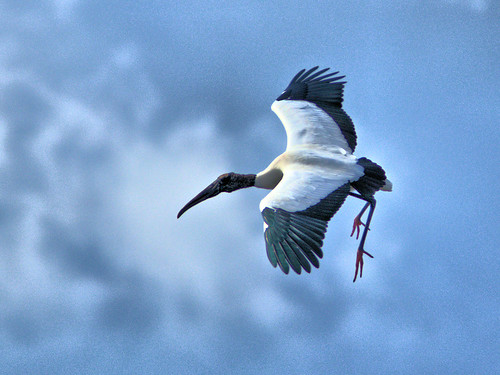

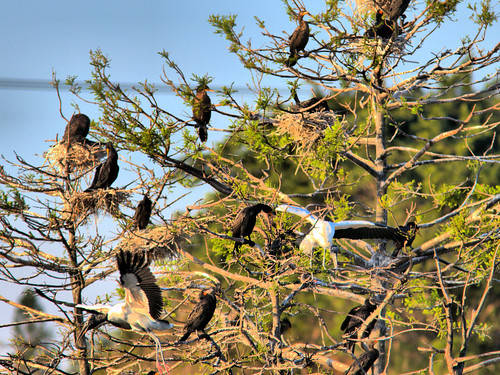
Eventually, 50 to 60 storks occupied 20 or more nests and my estimate is that they have produced over 30 young.
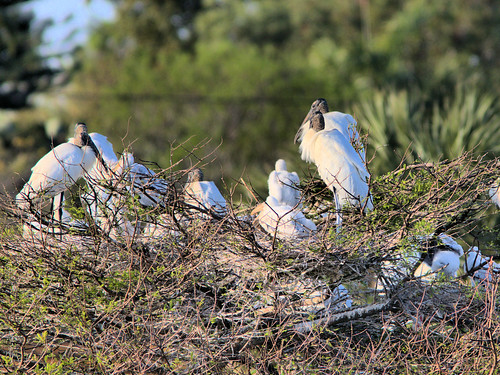
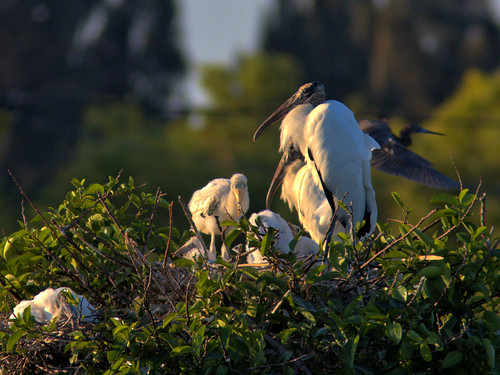
According to Cornell Lab of Ornithology eBird reports, this was a milestone, the first time in over 10 years that more than a few had been seen together within miles of this location.
When we moved to south Florida from New Mexico in 2004, Wood Storks were common breeders and visitors to our back yard lake. In my October, 2014 blog, "Wood Storks: Missing but not Endangered" I discussed the reason for the sharp decline in the Wood Stork population in south Florida:
" Drainage, filling of sloughs and development have altered the natural cycle, and aberrant rainfall patterns have complicated this balance. Summer drought or early onset of the wet season produce adverse conditions. Prolonged drought kills off the fish and their populations may take more than a year to recover even if water conditions are favorable. The 2012 wet season had much greater rainfall than normal, which was very favorable, but heavy rains during late winter reversed the drying process and dispersed prey, accounting for their failure to produce young during 2013."
The post also contains this photo, taken in 2010, of juvenile Wood Storks in our local wetlands:
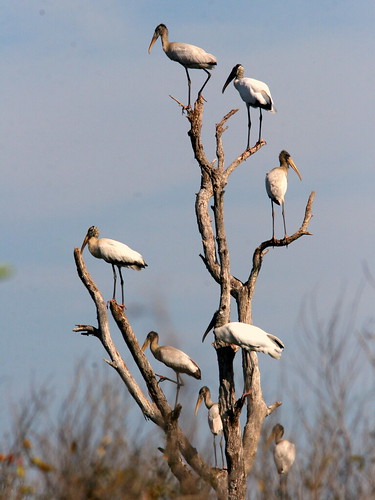
In a 2012 update to an earlier blog, "Struggling Storks" (October 5, 2010) I pointed out:
"Although the number of Wood Stork nests outside of South Florida have increased from 1817 in the 1970s to 5491 in the 2000s, the number of nests in South Florida have not recovered, ranging from from 2406 to 2367 over the same period. Nationally the percentage of nests at Corkscrew Swamp declined from 34-37% to only 8% of the US total. There has been total nesting failure at Corkscrew since 2010."
Despite the continuous decline and virtual disappearance of breeding Wood Storks in south Florida, in 2016 the US Fish and Wildlife Serve proceeded to remove the Wood Stork from the list of Endangered Species.
Thanks to more favorable weather conditions this past year (dryer in late summer which produced lower water levels), the local newcomers seem to be finding enough food for their youngsters. Tactile feeders, the storks depend upon lower water levels to concentrate their prey and shallow enough to allow them to keep their nostrils above the surface.
VIDEO (01:24): Wood Stork foraging in my back yard. If video fails to load, visit THIS VIMEO LINK
Wood Stork foraging from Ken Schneider on Vimeo.
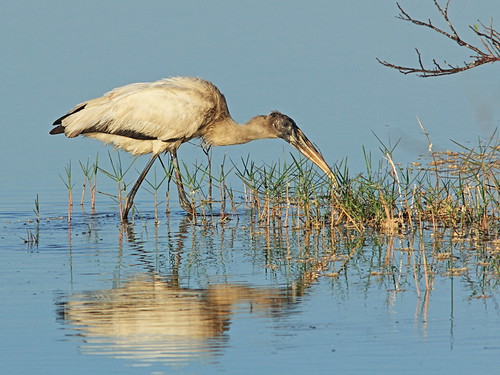
An adult stork rests along the boardwalk at the local Library wetlands:
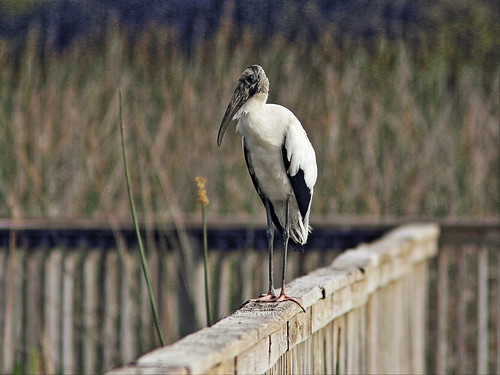
= = = = = = = = = = = = = = =
Linking to Misty's CAMERA CRITTERS,
Linking to Eileen's SATURDAY'S CRITTERS,
Linking to GOOD FENCES by Gosia
Linking to WEEKEND REFLECTIONS by James
Linking to BirdD'Pot by Anni
Linking to Wild Bird Wednesday by Stewart
Linking to Wordless Wednesday (on Tuesday) by NC Sue
Linking to ALL SEASONS by Jesh
________________________________________________
Please visit the links to all these memes to see some excellent photos on display
________________________________________________
My elder daughter wants to be a biologist and study how changes in climate affect migration of different species. It sounds dry and clinical until i see the pictures of the animals, and hear the story. It makes me wonder if there's any way to clean up our act in time and take better care of this pretty planet and its inhabitants.
ReplyDeleteWonderful photos of the Wood Storks!
ReplyDeleteMy favorite is the photo of them perched in the dead tree
Have a great day!
aw, wonderful shots. They are one of my favorite birds.
ReplyDeleteYou definitely are a 'birder' ~ wonderful bird photography ~ thanks,
ReplyDeleteWishing you a Happy Week ~ ^_^
Beautiful photos and reflections, Kenneth, and the one in flight is majestic. I also enjoyed the video, so nice to see. Thank you so much for sharing.
ReplyDeleteA brillient post, very informative, combined with excelent photos, its to hope that they have a good season, it will need more than fingers crossed for the future.
ReplyDeleteAll the best Gordon.
Wonderful to see the Wood Storks making a strong comeback!
ReplyDeleteFeel calm to see the fist picture you posted. Nice panorama view.
ReplyDeleteWhat an interesting and informative post!
ReplyDeleteWow- amazing shots, especially the second one!
ReplyDeleteHello, the wood storks are one of my favorite Florida birds. It is awesome they have returned to the area. Great shots. Thank you for linking up and sharing your post. Happy Saturday, enjoy your weekend!
ReplyDeleteI haven't seen stork in person and those are so plenty and beautiful. That first picture is so exceptional for me because i haven't taken a clear photo of a bird in flight. Thanks.
ReplyDeleteBeautiful photos Ken and interesting story on the Wood Storks. Happy to read they are making a come back. Thanks for your update.
ReplyDeleteSuch an awesome thing to be able to see and observe these wood storks. Such beautiful birds. We visited a town in Germany that had many stork nests that were built on homes and often on the chimneys. It was illegal to bother the nests even though it interrupted using your fireplace. They said the storks came back to the same nest every year and added "rooms". Some of the nests were huge.
ReplyDeleteWonderful photos of the storks! Glad they are back.
ReplyDeleteUnexpected...but oh so thrilling! What a sight!!!!
ReplyDeletePerhaps this is a good sign of a 'comeback' for that area. I loved ALL your photos and commentary today. And do keep us posted on their family raising if you can. I'm more than anxious to see the outcome of the season.
Thanks so much for linking in and sharing this with us birders at I'd Rather B Birdin' this weekend. It's much appreciated.
That's great news, Kenneth! Your captures of these beautiful birds are wonderful!
ReplyDeleteWonderful captures, I'm so envious!
ReplyDeleteWe don't have storks here so it's a thrill for me to see so many here. The capture of the one in flight is delightful.
ReplyDeleteThe black and white bird (2nd capture) is amazing! Animals are so dependent in their existence on nature's conditions. Nice conditions for the storks are better! Many thanks for sharing with All Seasons!
ReplyDeleteAbout your comment: have never tried tea with lemon grass (maybe because my mother used it in her cooking), but when the opportunity comes, I'll try it! Have a happy week!
Fascinating!
ReplyDeleteThanks for sharing these great shots and the interesting information accompanying your post!
http://image-in-ing.blogspot.com/2017/04/elvis-sighting-in-israel.html
Nice - and so rare good news on the bird front - I wonder if they will stay around.
ReplyDeleteCheers - Stewart M - Melbourne
Wow! What great subjects for your photos. I'd love to see these birds myself!
ReplyDeleteThese are great birds. Hope their nests work out! I've heard those statistics. Hopefully they can reverse the declining trend. Great photos!
ReplyDeleteThese are beautiful photos and interesting story on the storks.
ReplyDeletefantastic photos of the wood storks. Interesting text. Thank you.
ReplyDeleteWe just got back from a trip to Wakodahatchee and Green Cay wetlands. At Wakodahatchee there were hundreds of storks in nests -- a big rookery. I loved it. Hope to post some of my pictures soon.
ReplyDelete